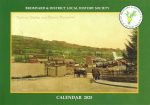 On June 14th Mandy Palmer, who leads the exhibition team welcomed a small crowd and introduced 95 year old Ken Hamnett who was evacuated during the war to Bishops Frome, aged 8. He lived with the Rosser family at Cheney Court Cottage. Ken and his daughter Julie told of his life during these years. Ken’s memory of how he was chosen by Mr and Mrs Rosser is so vivid. All the children were sat in playground in a school in Erdington Birmingham and there was a large group of people picking out children they could care for. Mrs Rosser said to Ken ‘would you like to come with us ‘ and he said ‘only if my friend Charlie Lovell can come too ‘ so they agreed on the both of them. Charlie stayed about 3 weeks in but he was homesick and returned home .
On June 14th Mandy Palmer, who leads the exhibition team welcomed a small crowd and introduced 95 year old Ken Hamnett who was evacuated during the war to Bishops Frome, aged 8. He lived with the Rosser family at Cheney Court Cottage. Ken and his daughter Julie told of his life during these years. Ken’s memory of how he was chosen by Mr and Mrs Rosser is so vivid. All the children were sat in playground in a school in Erdington Birmingham and there was a large group of people picking out children they could care for. Mrs Rosser said to Ken ‘would you like to come with us ‘ and he said ‘only if my friend Charlie Lovell can come too ‘ so they agreed on the both of them. Charlie stayed about 3 weeks in but he was homesick and returned home .
 Ken, pictured left, talks about Mr and Mrs Rosser every day. He speaks about him helping Mr Rosser with taking food to the farm hands, picking hops, and riding his pony Dandy [without a saddle] and having a lamb called ‘Ere as in Come Ere ! The lamb was fortunate to grow into a sheep and he looked after it throughout his time with them. He was also in the choir at the local church.
Ken, pictured left, talks about Mr and Mrs Rosser every day. He speaks about him helping Mr Rosser with taking food to the farm hands, picking hops, and riding his pony Dandy [without a saddle] and having a lamb called ‘Ere as in Come Ere ! The lamb was fortunate to grow into a sheep and he looked after it throughout his time with them. He was also in the choir at the local church.
Ken says Mr and Mrs Rosser’ did everything for him’. They even wanted to adopt him when his mother died while he was with them, his father had passed away just before he was born. His sister Pattie was very involved in his life visiting him regularly from Birmingham . She was 10 years older and was able to care for him. Unfortunately, Mrs Rosser died in 1949. Ken continued to contact Mr Rosser even when he was in the Navy, working in Birmingham and then moving to Stratford with Mum in 1959. They visited him in Bromyard several times and also sent him a postal order every year to say thank you for caring so much for him.
Also present was Daulton Hall, aged 84 who had delivered milk to Mr Rosser when he moved to Bromyard from Bishops Frome in the 1960s. Daulton spent a happy couple of hours reminiscing with Ken.
Member Hugh Langrishe, who is 102, told us about his experience in the Navy, where he heard the news of Victory in Europe (some 12 hours later!) whilst stationed on his ship off the coast of Australia. When they eventually heard that the war was over, Hugh said they may have all gone for a couple of drinks!
The exhibition is accompanied by a book packed with local photographs featuring street parties, local servicemen and women and lots more.
Thanks go to our fabulous Exhibitions team – Carmen Orgee, Ann Gould, Jennifer Storer, Ella Nosworthy, Mo & Claire Padfield, Mandy Palmer and Audrey Lowery – who have worked so hard to put this together.
More information on the exhibition below:
On May 8th, 1945, WWII in Europe came to an end. As the news of Germany’s surrender reached the rest of the world, joyous crowds gathered to celebrate in the streets of Bromyard, clutching newspapers that declared “Victory in Europe”, V-E Day.
When victory eventually came a weary nation were understandably keen to celebrate; street parties and parades were held, bonfires lit and church bells were rung.
 But it was a day of mixed emotions; many people felt unable to celebrate as they mourned the death of a loved one, or worried about those who were still overseas.
But it was a day of mixed emotions; many people felt unable to celebrate as they mourned the death of a loved one, or worried about those who were still overseas.
For people in Bromyard and the rest of the country, the end of the fighting didn’t mean an end to the impact of the war on their lives. Although many things slowly began to return to normal, it took time to rebuild the country, rationing remaining for several years.
THE LAND ARMY
Away from the well-documented horror of the battlefields, World War Two was a time of immense social change. The Women’s Land Army, affectionately known as ‘Land Girls’ were a big part of that, as labour shortages meant women took on the roles traditionally held by men.
By 1934 there were more than 80,000 Land Girls. Women like Joan Watkins, Peggy Calder, Gladys Hoskins and Joy Atkins. Come and learn more about their fascinating stories and the important contribution the women working in Bromyard made to the war effort.
EVACUEES
The evacuees had to adapt quickly to country life coming from London and Birmingham for some, it was the first time the bus services were frequent, if you lived outside of Bromyard or in a small hamlet you might have to walk two to three miles to school. they had seen cows, sheep, chickens and pigs. It was strange going into homes not knowing the families they were placed with, leaving their mothers and sometimes being separated from their brothers and sisters as some households could only take one child. Transport was another problem as in London and other cities
RATIONING
 When World War II began in September 1939, petrol was the first commodity to be controlled. On 8 January 1940, bacon, butter, and sugar were rationed. Meat, tea, jam, biscuits, breakfast cereals, cheese, eggs, lard, milk, canned and dried fruit were rationed subsequently, though not all at once. In June 1942, the Combined Food Board was set up by the United Kingdom and the United States to coordinate the world supply of food to the Allies, with special attention to flows from the U.S. and Canada to Britain. Almost all foods apart from vegetables and bread were rationed by August 1942. Strict rationing created a black market. Almost all controlled items were rationed by weight; but meat was rationed by price.
When World War II began in September 1939, petrol was the first commodity to be controlled. On 8 January 1940, bacon, butter, and sugar were rationed. Meat, tea, jam, biscuits, breakfast cereals, cheese, eggs, lard, milk, canned and dried fruit were rationed subsequently, though not all at once. In June 1942, the Combined Food Board was set up by the United Kingdom and the United States to coordinate the world supply of food to the Allies, with special attention to flows from the U.S. and Canada to Britain. Almost all foods apart from vegetables and bread were rationed by August 1942. Strict rationing created a black market. Almost all controlled items were rationed by weight; but meat was rationed by price.
THE HOME GUARD
Men who were eager to ‘do their bit’ but were unable to enlist for the regular forces due to age or being in a reserved occupation joined the Home Guard. Despite being seemingly far from the action Herefordshire’s Home Guard platoons still had important work to do; they were tasked with monitoring the skies for German bombers and trained in street fighting in preparation for any invasion. Alongside them existed a ‘secret army’ – the Auxiliary Units – who in the event of an invasion were expected to go to ground in their base, living underground for up to two weeks before emerging to carry out acts of sabotage and provide useful intelligence.
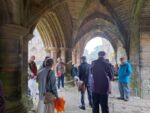 On 12th June 2025 we enjoyed a group visit to Wenlock Priory which followed on from Will Motley’s talk on 9th April. We arrived in the morning with time for coffee, exploring the town and lunch before our visit to the Priory itself. The Museum was interesting and informative and the church and Guildhall also worth visiting.
On 12th June 2025 we enjoyed a group visit to Wenlock Priory which followed on from Will Motley’s talk on 9th April. We arrived in the morning with time for coffee, exploring the town and lunch before our visit to the Priory itself. The Museum was interesting and informative and the church and Guildhall also worth visiting.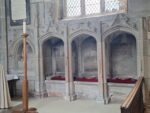 Whilst the morning was dry, as we headed to the Priory reception, the rain started and lasted for most of our visit. Fortunately, there were trees and a remaining roofed part of the Cloister to shelter under whilst our guide, Susan, gave us an informative and interactive talk about the history of the Priory and remaining stonework. Happily, we were joined by Will Motley who was able to add lots of interesting detail.
Whilst the morning was dry, as we headed to the Priory reception, the rain started and lasted for most of our visit. Fortunately, there were trees and a remaining roofed part of the Cloister to shelter under whilst our guide, Susan, gave us an informative and interactive talk about the history of the Priory and remaining stonework. Happily, we were joined by Will Motley who was able to add lots of interesting detail.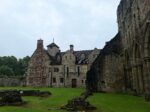 The rain eased off a little allowing us to explore the ruins of which the elaborately carved Norman Chapter House was particularly stunning. There was also the lavabo, cloister garden with anthropomorphic topiary, and a collection of Mediaeval to Victorian tiles to admire.
The rain eased off a little allowing us to explore the ruins of which the elaborately carved Norman Chapter House was particularly stunning. There was also the lavabo, cloister garden with anthropomorphic topiary, and a collection of Mediaeval to Victorian tiles to admire.




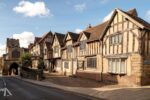

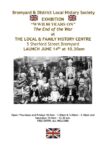



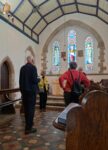
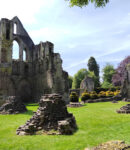
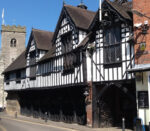


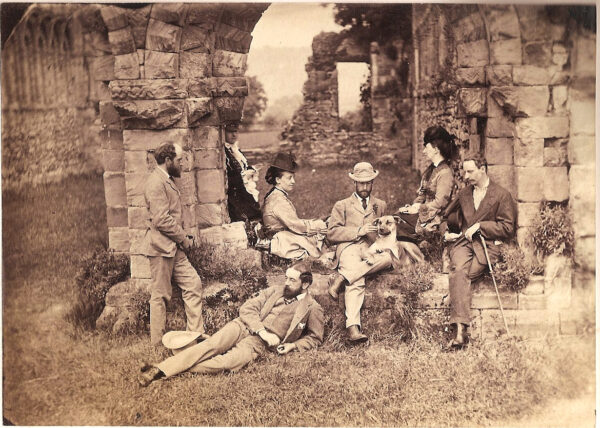
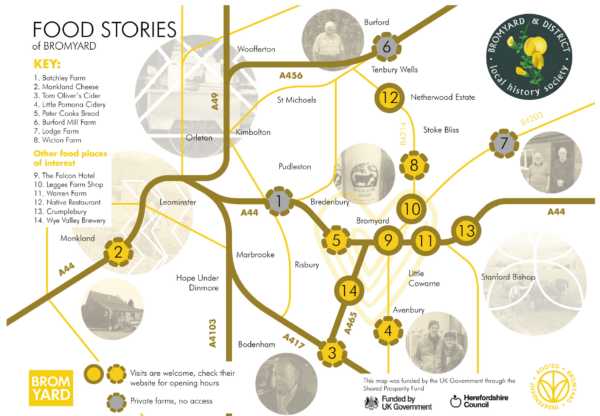
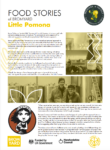

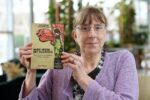
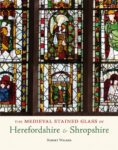
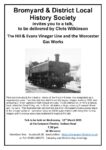
 On Sunday 8th December we met at the Falcon for the Bromyard and District Local History Society Christmas Lunch. Sue Cooper welcomed us and introduced Jane Bradley and her Food Stories of Bromyard information boards.
On Sunday 8th December we met at the Falcon for the Bromyard and District Local History Society Christmas Lunch. Sue Cooper welcomed us and introduced Jane Bradley and her Food Stories of Bromyard information boards. 